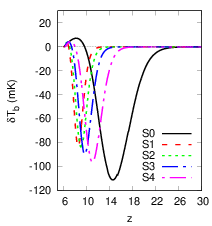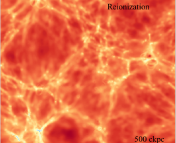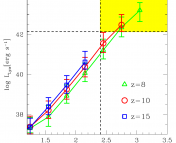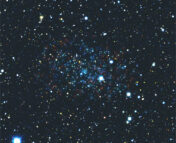Title: Fuzzy Dark Matter at Cosmic Dawn: New 21-cm Constraints
Authors: Olof Nebrin, Raghunath Ghara and Garrelt Mellema
First Author’s Institution: Department of Astronomy and Oskar Klein Centre, Stockholm University
Status: Published in JCAP, available on arXiv.
There’s a problem in cosmology! Despite its many successes on large cosmological scales, the standard cosmological model—called Lambda-CDM—gets things wrong on the (cosmologically) tiny scales of galaxies. These problems stem from the CDM part of Lambda-CDM: cold dark matter. Today’s paper seeks to fix these problems by replacing the cold dark matter of Lambda-CDM with a different type of dark matter: the adorably named Fuzzy Dark Matter (FDM).
General theories of structure formation predict that dark matter collapses before normal matter does, which leads to bound structures in the universe (galaxies and clusters) being embedded in a larger “halo” of dark matter. Lambda-CDM predicts that the density of the dark matter at the centre of the halos should be very densely packed (this central region is called a cusp). However, measurements of dwarf galaxies seem to indicate that the dark matter halo forms a flat central “core” extending from the centre out a few thousand lightyears, instead of a dense cusp. This “core-cusp problem” of dwarf galaxies is discussed in more detail in this astrobite, and is the first problem FDM hopes to solve.

In addition to predicting cuspy centres of dwarf galaxies, Lambda-CDM also predicts that there should be more dwarf galaxies in orbit around the Milky Way than we observe. This is the second problem FDM hopes to fix, called the “missing satellite problem.” Fixing both of these problems simultaneously is generally difficult (another dark matter theory, warm dark matter, can solve one at a time, but not both) which makes FDM an attractive solution.
What makes it fuzzy?
The idea behind fuzzy dark matter is to make dark matter out of some new, extremely light particle.
Such ultralight dark matter particles begin to show their quantum properties on astronomical length scales. In particular, the dark matter particles will behave more like waves than individual particles on astronomical scales, smearing out their gravitational influence. The wavelength of a particle is set by its mass, with heavier particles having smaller wavelengths. To have the right wavelength to solve both the core-cusp and the missing satellite problem, the dark matter particle needs a mass of about 10−22 eV/c2, which is 27 orders of magnitude lighter than the electron! This “smearing” of the dark matter into a wave means that dark matter cannot cluster as much on sizes smaller than its wavelength (solving the lack of dwarf galaxies), and the dense cusps which Lambda-CDM predicts become smoothed out. To add to the appeal, on scales much bigger than the wavelength of FDM particles, this fuzziness stops mattering, and FDM acts the same as CDM, collecting the large scale successes of Lambda-CDM as its own.
Searching for FDM using the first stars
The authors of today’s paper use the rate of star formation in the early universe to track how quickly structure forms. The first stars are expected to form in small dwarf galaxies (the kinds of structure FDM limits), so we can test how heavy the FDM mass can be based on the star formation rate throughout the Era of Reionisation. Because the universe was transitioning from neutral hydrogen to ionised gas in this era, information about this period is imprinted in the 21 cm “spin-flip” spectral line of hydrogen.

The models used in this paper depend both on the FDM mass and astrophysical quantities (e.g. what fraction of gas ends up in stars and how efficiently the UV light from stars ionises the neutral hydrogen). For a fixed FDM mass, these astrophysical quantities were estimated by requiring that reionisation ends at the right time to match other observations.

The authors of this paper calculated the effect of these fixed FDM models on several different signals that can be measured using the 21 cm line. The simplest, and most constraining effect is shown in Figure 3, which shows the overall brightness of the 21 cm line over time. The peak of the signal (the bottom of the dip) happens later and is narrower for FDM models than Lambda-CDM. The EDGES high band experiment constrains how wide this signal curve is, which places a bound on the allowed FDM mass.
After considering all the effects on the 21 cm line (not just the overall brightness), the authors found that, to be compatible with EDGES high band data, the lower bound on the FDM mass is either 6×10-22 or 20×10−22 eV/c2, depending on how conservative they were while estimating astrophysical quantities. Unfortunately for FDM, a mass this high means that the wavelength of FDM is too small to solve the problems with Lambda-CDM. So while it doesn’t rule out FDM’s existence, it does mean that we’d need to find a different solution to the problems posed by Lambda-CDM. And so the hunt for the nature of dark matter continues!
Astrobite edited by Pratik Gandhi and Ellis Avallone
Featured image from Philip Mocz





Have anyone analyse, what effect will be if the cold matter is not one substance? For example, how will be affected the density profiles of DM and 21cm brightness if the DM is a mix of the CDM and the FDM?
Hi Pavel! The effect on both structure formation and the density profiles in halos will be lessened compared to CDM. The thing is that FDM was astrophysically motivated as being able to solve problems facing LCDM on its own (and simulations now seem to point very strongly to CDM with accurate baryonic feedback can solve the previous problems facing CDM). When you need CDM to save FDM, it greatly loses its appeal. It also leads to questions of why the two components would have abundances of the same order.
For anyone interested in the cover image for this post, it comes from my tutorial on how to create your own simulations of fuzzy dark matter (simple Python code included): https://levelup.gitconnected.com/create-your-own-quantum-mechanics-simulation-with-python-51e215346798?source=friends_link&sk=e4ddefcc5981368124e08cf70d9081b6
Yes! I highly recommend this tutorial. I used a (slightly adapted) version of the code in this tutorial to create the thumbnail image for this article